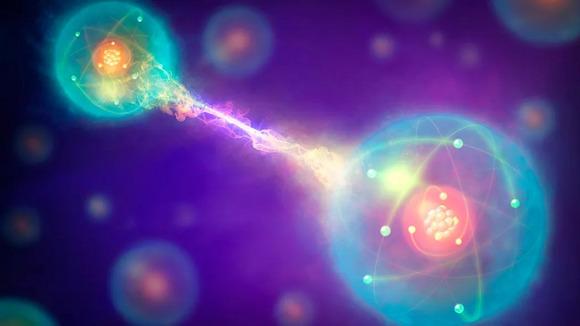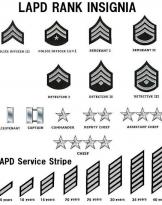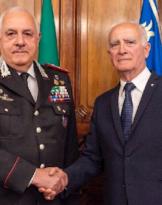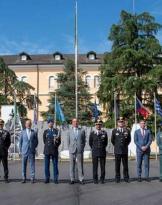The Royal Swedish Academy of Sciences awarded Alain Aspect, John F. ClauserAnton Zeilinger with the Nobel Prize in Physics 2022 "for experiments with entangled photons, establishing the violation of Bell's inequalities and pioneering quantum information science".
Research is advancing more and more on fields such as quantum computers and secure quantum encrypted communication and the turning point is how quantum mechanics1 (MQ) allows two or more particles to exist in what is called a state entangled. What happens to one of the particles in an entangled pair determines what happens to the other particle, even if they are very far apart.
Quantum technologies are dual-use technologies and, as such, are of interest to the defense and security industry and to military and government agencies. Quantum technologies for military applications introduce new capabilities, improving effectiveness and increasing accuracy, thus leading to "quantum warfare"2. Quantum technology does not fundamentally bring new weapons or autonomous military systems but rather significantly improves the measurement capability, detection, accuracy and computing power and efficiency of current and future military technology.
But what are the possible future applications of technologies deriving from quantum physics studies?
What is certain is that the full understanding of quantum mechanics is not exactly a very simple exercise "Presents significant conceptual and formal obstacles and requires a change in ways of thinking, imagining and reasoning that can be very tiring."3 Although we are often unaware of it, the technologies deriving from QM are before our eyes. Examples of the first generation of quantum technologies are semiconductors and transistors; now, with the advanced studies on superimposition ed entangling the second generation is underway
Here we will try to approach rather complex themes depriving ourselves of the charm of retracing and exposing some concepts, albeit basic, of quantum mechanics and advanced mathematics notions to support them, hoping to succeed in expressing complicated concepts with "simple" words .
We can say that quantum mechanics describes matter and radiation in all its aspects, in particular as regards microscopic phenomena, that is, which occur on an atomic scale. Quantum laws are not deterministic but probabilistic. That is, they cannot predict the events that will happen in the evolution of a physical system but only the probabilities with which different events may occur.
This probabilistic approach has led to a better understanding of some key properties of quantum particles that underlie quantum technologies, in particular "superposition" andentanglement stimulating the development of such next generation technologies such as quantum sensing, quantum computing and quantum computing.
In the context of defense and security we are going to very briefly analyze some applications deriving from the studies carried out on quantum mechanics.
Quantum sensors achieve extreme levels of precision by exploiting the quantum nature of matter, using the difference between, for example, electrons in different energy states as the basic unit. They could be used in the detection of submarines and aircraft stealth as well as to allow navigation without the need for external references such as GPS, using quantum PNT devices (positioning, navigation and timing devices).
Quantum technologies can improve i positioning, navigation and timing systems (PNT), in particular inertial navigation. The quantum advantage will manifest itself for GPS operating environments, allowing precise operations to be carried out.
Current GNSS (Global Navigation Satellite System) rely on precise timing provided through multiple atomic clocks in individual satellites which are corrected by the most stable atomic clocks on earth. The higher accuracy of the quantum clock will also increase the accuracy of positioning and navigation. GNSS technology is subject to jamming and in underground or submarine environments, it is not available at all. The solution is there inertial navigation. The problem with classic inertial navigation is the loss of accuracy over time (drift of 1,8 km / day for ships and submarines and 1,5 km / hour for military aircraft). For a modern army, in order to improve battlefield operations, it is imperative to have measurements that are as accurate as possible. In quantum underwater warfare, submarines may be the first to adopt quantum inertial navigation by employing quantum magnetometers as the primary tool for detecting submarines or submarine mines by applying quantum photodetector, radar, lidar or gravity based detection.
Another field is theimaging quantum which offers applications such as quantum radar which could be used for the space war. The theoretical advantages and characteristics of quantum radar are greater resistance jamming and other electronic warfare countermeasures; the output signal strength is so low that it will be invisible to electronic warfare measures. In addition to the high costs, skepticism remains about stealth target detection or jam resistance.
Other applications in the industry relate to quantum lidar which uses optical or quasi-optical photons and could be used for target illumination at short distances by operating anti-drone surveillance radar or as part of a complex Short Range Air Defense.
Quantum computing brings with it the so-called "quantum threat" and as known for the military, secure communications and information are of paramount importance. Nobel laureate Zeilinger demonstrated a phenomenon called quantum teleportation which effectively allows the transmission of information at a distance.
In classical information science, the elementary vector of information is a bit that can only be 0 or 1. The elementary vector of quantum information is the quantum bit, qubit. A qubit can be | 0⟩ | 0⟩ or | 1⟩ | 1⟩4, or an arbitrary complex linear combination of states | 0⟩ | 0⟩ and | 1⟩ | 1 ° called quantum superposition. The other important property is thequantum entanglement. It refers to a strong correlation between two or more qubits.
While classical computers perform computations using binary digits (0 or 1), quantum computers represent information using qubits which can be in both states at the same time and can also affect each other even if they are not physically connected. Other differences are the cd interference that is, the possibility of qbits to be entangled that is to be intertwined with each other resulting in a close correlation between them.
L'entanglement shared on a global scale will allow quantum computers to work together to solve complex problems that are inaccessible with today's supercomputers
As mentioned, Zeilinger demonstrated the teleportation of the state of individual qubits and also showed how shared entanglement can be transformed into shared secret keys that would allow for secure communications whose security promises derive from the fact that the laws of quantum physics are true. Quantum computers, being able to carry out a considerable amount of calculations at the same time, can have applications such as "factorization of integers, which allows the decryption of the most commonly used IT security protocols ". Quantum networks "they promise an inherently secure communication mechanism that will enable the secure transmission of information, even when attacked by adversaries with quantum computers."
The first application of quantum communication is called Quantum Key Distribution (QKD) which uses quantum particles for the exchange of cryptographic keys. In QKD, the actual data is transmitted over a traditional communication infrastructure using normal bits, however, the cryptographic keys needed to decrypt the data are transmitted separately using quantum particles. For the defense this technology will be interesting when long distance communication using MDI-QKD or quantum repeaters becomes possible. Currently, there is basic commercial technology available that uses reliable repeaters. In addition to the QKD, the quantum network could be used for secure quantum direct communication (QSDC) between space, special forces, the navy and land resources.
The other application is the quantum cryptography location-based that can offer more secure communication, where information accessed will only be available from a particular geographic location, such as communication with military satellites only from particular military bases.
Military technologies have more demanding requirements than industrial or public applications. Quantum technologies can impact all domains of modern warfare. The second quantum revolution will improve sensitivity and efficiency, introduce new capabilities and refine modern warfare techniques rather than lead to new types of weapons. Let's not forget that many applications are even more theoretical than realistic and laboratory advances do not always translate outside of them with the same success.
1 Quantum warfare is a war that uses quantum technologies for military applications that affect the intelligence, security and defense capabilities of all domains of warfare, and introduces new military strategies, doctrines, scenarios and peace, as well as ethical issues.
2 DJ Griffiths "Introduction to quantum mechanics"; G. Nardulli “Quantum mechanics vols. 1 - 2 "
3 U. Besson "Didactics of physics"
4 Bra-ket notation or Dirac formalism.
@ All rights reserved












